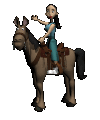The Physics of Horse Jumping
A horse has multiple gaits. A walk, a four beat gait, a trot, a two beat gait and a canter, a three beat gait. The most common gait to jump from is the canter because it allows the rider to have a more consistent velocity to jump. In order to balance the rider goes into a position, which is known as a 2-point during the flight.
There are four phases of a jump, approach, takeoff, flight and land. In the first phase of the jump (approach) the horse only has kinetic energy which can be expressed by .
During the takeoff the horse uses Newton's Second Law of motion to push itself off the ground. After takeoff the horse only has potential energy. This can be shown by PE=mgh. At maximum height the potential energy is at its maximum while the kinetic energy is zero, which means that the velocity is zero. Thus, the only force acting on the horse is gravity, a=g=9.81 m/s2.
Last, the horse lands and has kinetic energy. The horse returns to the original velocity. Since this happened the forces during the jump can be added together, where it should equal zero. The horse's energy goes from kinetic to potential to kinetic. This is known as the Law of Conservation, which can be shown by the formula .



1 Comment
Recommended Comments